2025 North Atlantic right whale calving season
2025 North Atlantic right whale calving season
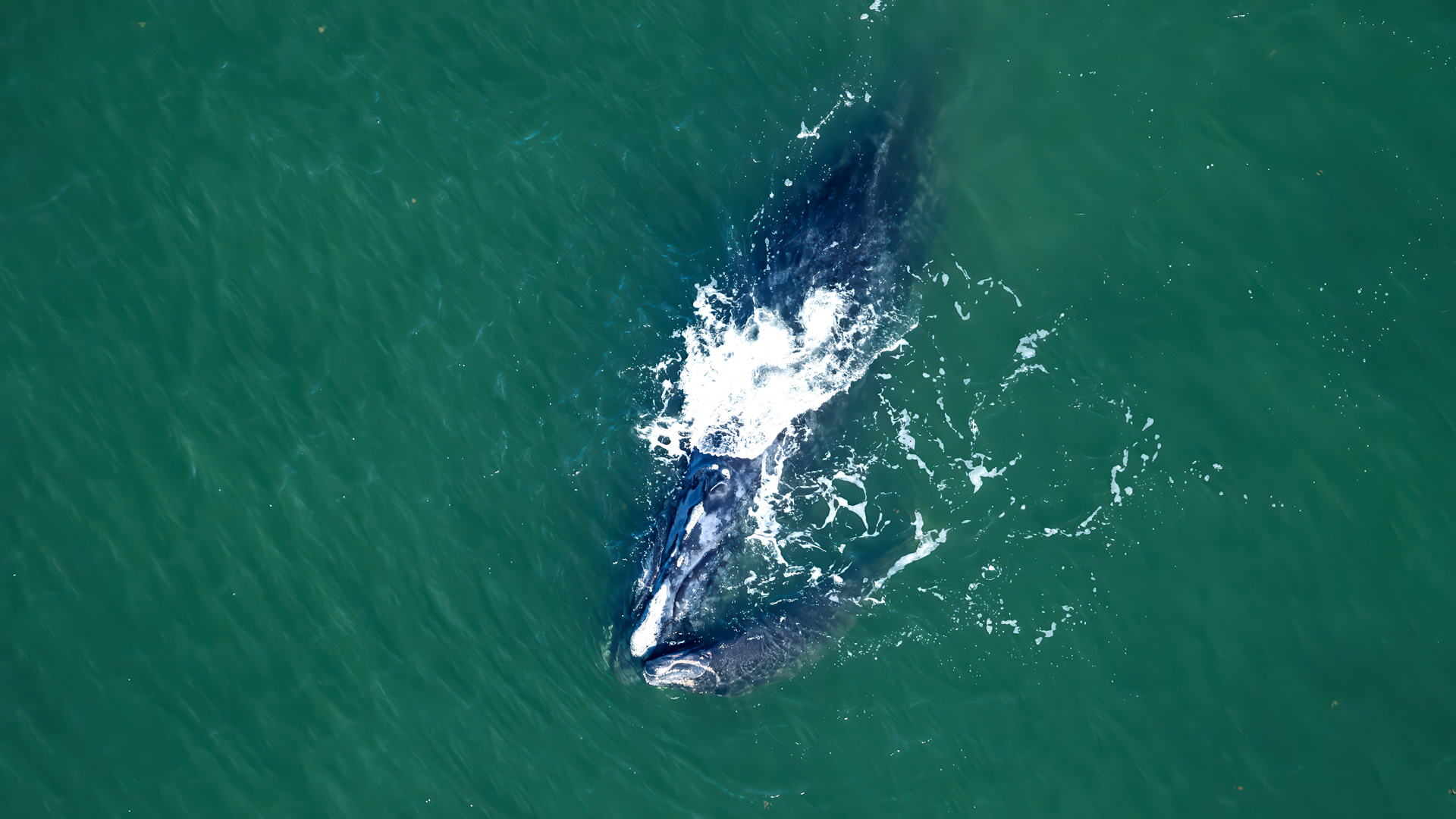
With only around 370 North Atlantic right whales remaining in the ocean, every individual matters for the survival of this critically endangered species. That’s why every year, in the southeastern US, we track the births of new North Atlantic right whale calves.
Sadly, North Atlantic right whales face threats in the form of vessel strikes, entanglement in fishing gear, ocean noise pollution, and climate change. They can live up to 70 years, but increasing fishing and boating activities—not to mention the imminent threat climate change poses to ocean temperatures—shorten the lifespans of these magnificent marine mammals, who are some of the largest living animals on Earth.
North Atlantic right whales are not reproducing fast enough to offset their deaths. Since NOAA declared an Unusual Mortality Event in 2017, there have been 41 documented right whale deaths, 37 serious injuries and 70 morbidities, which represents over 35% of the current North Atlantic right whale population. Further, research suggests that that only 1/3 of right whale deaths are documented, so the death toll is likely much higher. In comparison, there have only been 88 births in this same period—and at least nine of those calves died in the same season they were born.
The North Atlantic right whale calving season begins each year in mid-November and ends around mid-April. With only 70 reproductive female North Atlantic right whales remaining, we keep a close watch on them and their new calves to help ensure their survival. Considering these current numbers, 20 new calf births would be considered a relatively productive calving season. However, given the high rate of mortality and injury, North Atlantic right whales need to have at least 50 new calves per year to recover and grow their population. If the species fell to only 50 reproductive females, they would become functionally extinct.
To stay up to date with the latest 2025 North Atlantic Right Whale Calving Season news and receive updates about the births of new whale calves, bookmark this page and check back in regularly. You can also follow us on Instagram, Facebook, and TikTok for live updates.
Unidentified calf
The first, though unidentified, North Atlantic right whale calf of the 2025 season has been spotted! This newborn whale was spotted off Cape Romain, South Carolina, alongside its mother—potentially either Black Heart (Catalog #3540), Koala (Catalog #3940), or Curlew (Catalog #4190). Typically, researchers identify individual whales by their physical features, but clearly identifiable images of this pair are not yet available. With additional sightings, researchers should be able to determine who’s the new mama—so stay tuned!
Three potential whale moms were all spotted off the Carolina coast between November 20 and 25. Thanks to a boater’s report, researchers were notified of the calf’s presence.
Safety is paramount—if you’re out on the water, post a lookout and use caution. Report any right whale sightings to 1-877-WHALE-HELP (877-942-5343) or to the USCG on VHF Channel 16. You can also download IFAW’s Whale Alert app to be aware of whales in your area and report sightings.
Calf of Nauset (Catalog #2413)

The first identified mother of the season, Nauset (Catalog #2413), was spotted with her new calf on December 1 near Sapelo Island, Georgia. At 31 years old, this is Nauset’s fifth calf, and she last gave birth four years ago.
Calf of Minus One (Catalog #2430)

On December 9, off Amelia Island, Florida, North Atlantic right whale Minus One (Catalog #2430) was spotted with her newborn calf. At least 31 years old, Minus One is a seasoned mother. This is her fourth calf, and her first in four years—a strong birth rate for a struggling population.
Calf of Catalog #4540
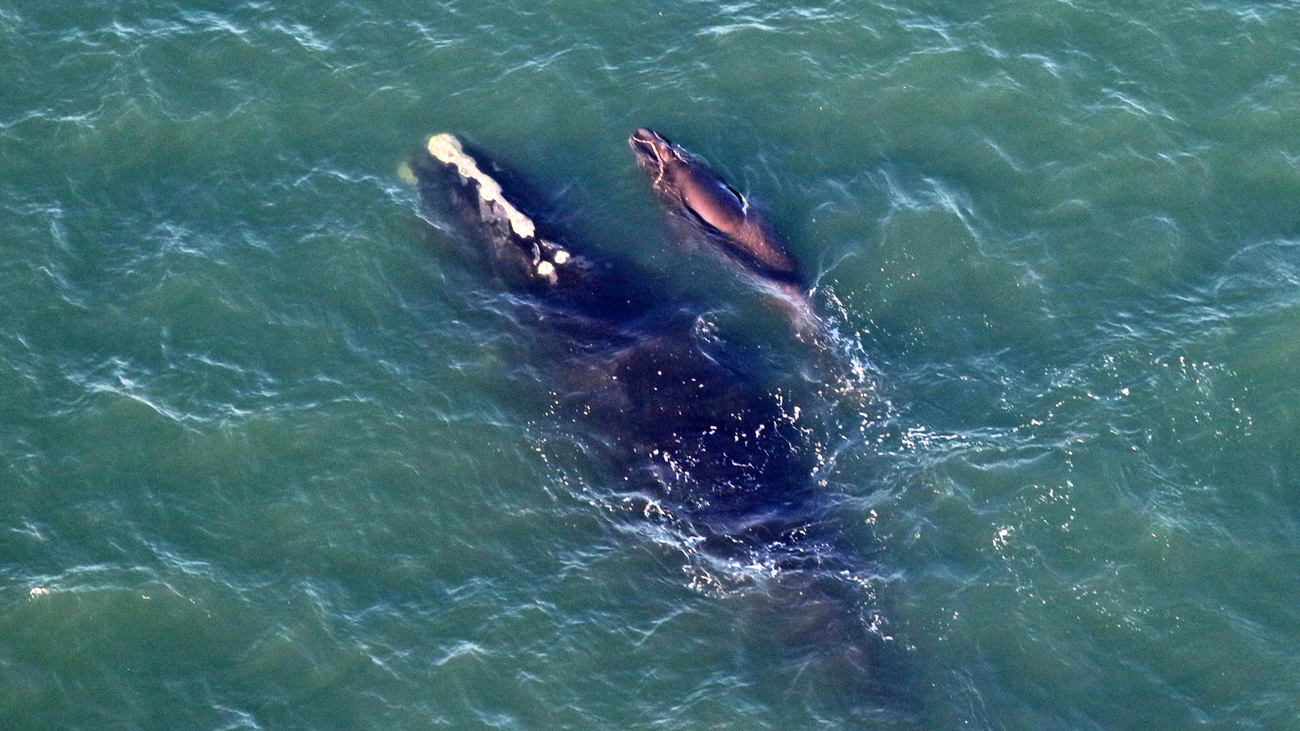
This calf was sighted on December 18 off the coast of Virginia. Congratulations to North Atlantic right whale Catalog #4540—at 12 years old, this is her first-ever calf! Her own mother, sister, and niece are all still alive and giving us hope for the species. We wish the pair safe travels and the mother many more fruitful years of calving.
Calf of Caterpillar (Catalog #3503)
Two North Atlantic right whale mothers gave birth to calves at the end of December to ring in the new year! One was Caterpillar (Catalog #3503), a 20-year-old first-time mother. She and her calf were spotted on December 30 off the Guana Tolomato Matanzas National Estuarine Research Reserve (GTMNERR), located in Ponte Vedra, Florida.
Calf of Blackheart (Catalog #3540)
Also sighted on December 30 were right whale mother Blackheart (Catalog #3540) and her new calf. Like Caterpillar, Blackheart is 20 years old and was seen nearby off the GTMNERR. However, she is a more experienced mother, as she gave birth to another calf 12 years ago.
Calf of Grand Teton (Catalog #1145)
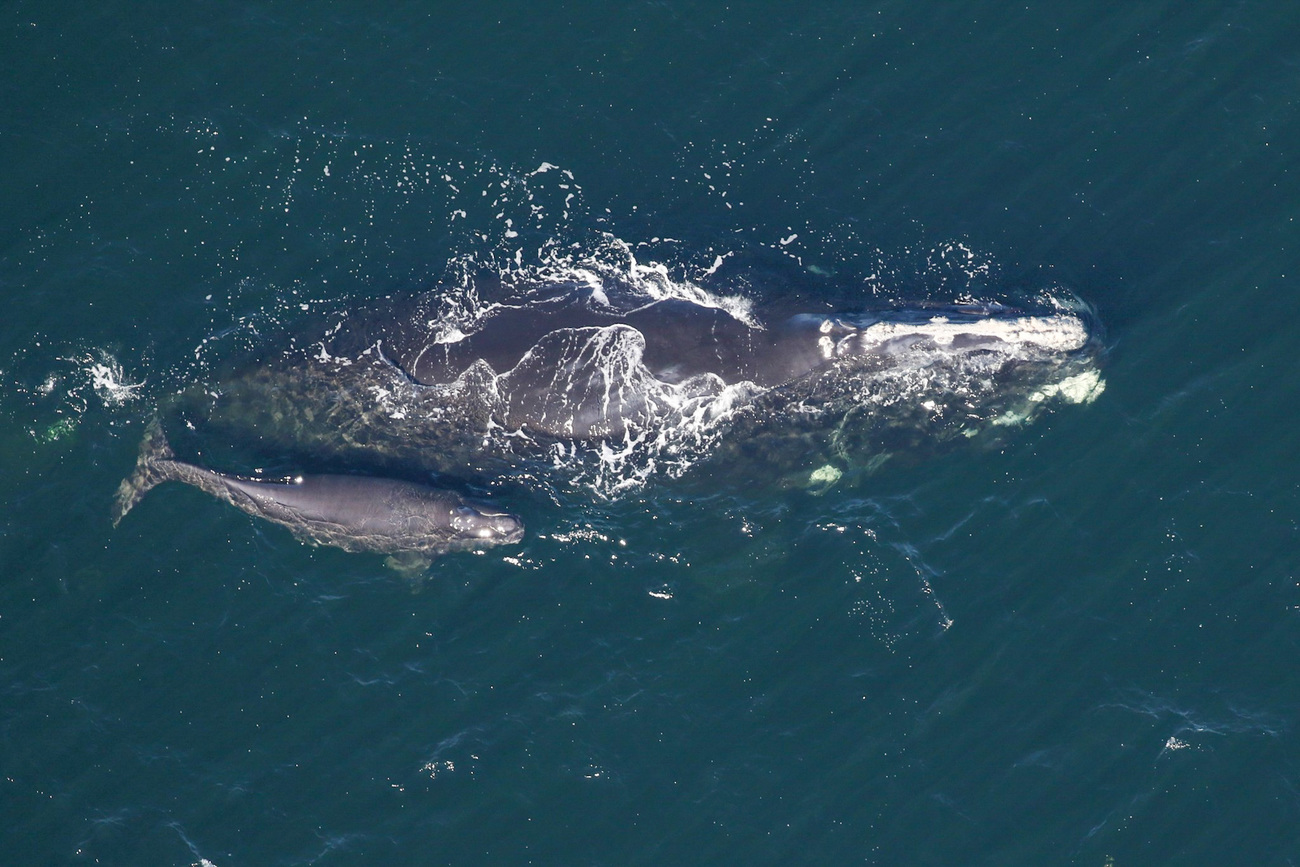
The first right whale calf of 2025 is here! Spotted on January 16 off Amelia Island, Florida, this is the ninth calf of 44-year-old mother Grand Teton (Catalog #1145). She last gave birth four years ago. Grand Teton is a marvel for her age—while North Atlantic right whales can have a lifespan of up to 70 years, only 10% survive past 47.2 years, due to human impact. Many female whales unfortunately don’t survive long enough to give birth—so Grand Teton’s nine births is certainly a marked achievement for the survival of the species.
Calf of Check Mark (Catalog #3705)
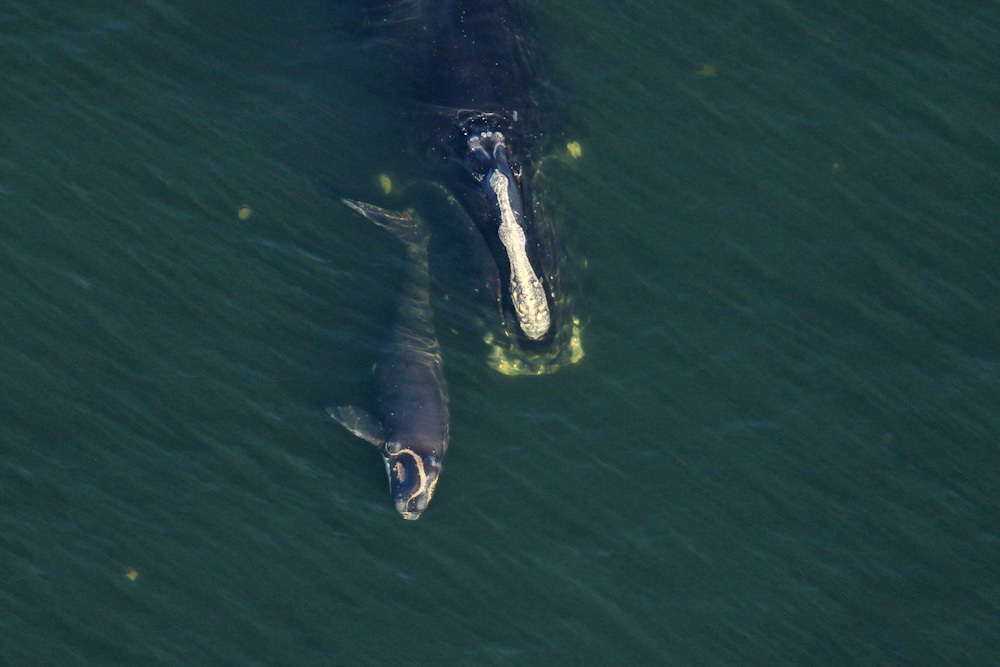
On January 17, a calf was spotted with new mother Catalog #3705, known as Check Mark, near Amelia Island, Florida. At 18 years old, she has given birth to her first-ever calf.
Typically, female right whales become mature at age 10 and give birth every three years, but human-caused threats like entanglement are causing so much stress in this species that their birth rates have declined significantly. Seeing a female right whale give birth for the first time is a much-needed sign of hope and perseverance.
Calf of Accordion (Catalog #4150)
Accordion (Catalog #4150) was seen with a calf on February 3 off New York—not a typical location for a mother-calf pair, as they usually give birth in the Southeast. Recognized by the healed wound on her back from a vessel propeller strike, Accordion is at least 14 years old, and this is her first calf—a hopeful sign for this whale who has gone through serious trauma.
Calf of Cashew (Catalog #3292)
Right whale Catalog #3292, known as Cashew, was spotted with a calf on February 5 near Amelia Island, Florida. At 23 years old, this is Cashew’s third calf. Her last calf was born 10 years ago.
Calf of Platypus (Catalog #3420)
On February 23, right whale Catalog #3420, nicknamed Platypus, was seen with a new calf near Ormond Beach, Florida. Platypus gave birth for the first time 10 years ago, and this is her second calf.
Born in 2004, Platypus is 21 years old—and she is part of a thriving right whale family. Her mother, known as Monarch (Catalog #2460), is still alive, and last gave birth to Platypus’ little sister in 2021. Platypus also has a living brother, born in 2010.
As we approach the tail end of calving season, we continue to have hope that we’ll see more new mothers and calves, and that the eleven born thus far will be safe from the dangers of vessel strikes and entanglement that unfortunately plague their waters.
Calf of Monarch (Catalog #2460)
In a surprise finding after the season was thought to be over—aerial observers with the Center for Coastal Studies documented a previously undetected mother and calf pair, north of Sandy Neck Beach in Barnstable, Massachusetts. Spotted on April 17, this sighting brings the total number of right whale calves for the 2025 season to 11, with seven mom-and-calf pairs now observed in Cape Cod Bay.
Discovering a new calf outside the species’ typical calving grounds is both rare and remarkable, reinforcing the importance of vigilant monitoring and collaboration. Monarch (Catalog #2460) is an experienced mother with at least one known daughter, who had a calf of her own this season—making this a multi-generational moment of hope for this critically endangered species.
The North Atlantic Right Whale Catalog keeps track of every whale and whale calf identified by researchers. Every whale is assigned a four-digit number, but many are also given names—especially those that have unique physical features or interesting stories.
20 new calves were born last year during the 2024 season, but sadly five have died or are presumed to have died.
Researchers identified 12 new calves during the 2023 season. Among these was the first calf of the whale known as Pilgrim (#4340), who is ten years old.

Fifteen new calves were observed in the 2022 season. One mother whale, Catalog #1515, was seen with her eighth calf off the coast of Georgia. She is estimated to be over 39 years old. The current record for most calves birthed by a North Atlantic right whale (that we know of) is nine. All of these mothers have survived numerous entanglements, with one even giving birth and nursing her calf with a piece of fishing equipment still stuck on her body.
In the 2021 calving season, 20 new calves were born. Unfortunately, two of them became victims of fatal vessel strikes. Their bodies were found washed ashore in Florida and North Carolina. Another calf, observed near Spain’s Canary Islands, was seen without its mother, which means it also likely did not survive.
Past numbers include only 10 calves in 2020, seven calves in 2019, zero in 2018, and five in 2017. Here’s how many right whale calves have been born since the 2007 season:
- 2024: 19 calves
- 2023: 12 calves
- 2022: 15 calves
- 2021: 20 calves
- 2020: 10 calves
- 2019: 7 calves
- 2018: 0 calves
- 2017: 5 calves
- 2016: 14 calves
- 2015: 17 calves
- 2014: 11 calves
- 2013: 20 calves
- 2012: 7 calves
- 2011: 22 calves
- 2010: 19 calves
- 2009: 39 calves
- 2008: 23 calves
- 2007: 23 calves
Between the years of 2007 and 2022, 15.7 calves were born on average each season. Since the Unusual Mortality Event that was declared in 2017, only 11 have been born on average each season.
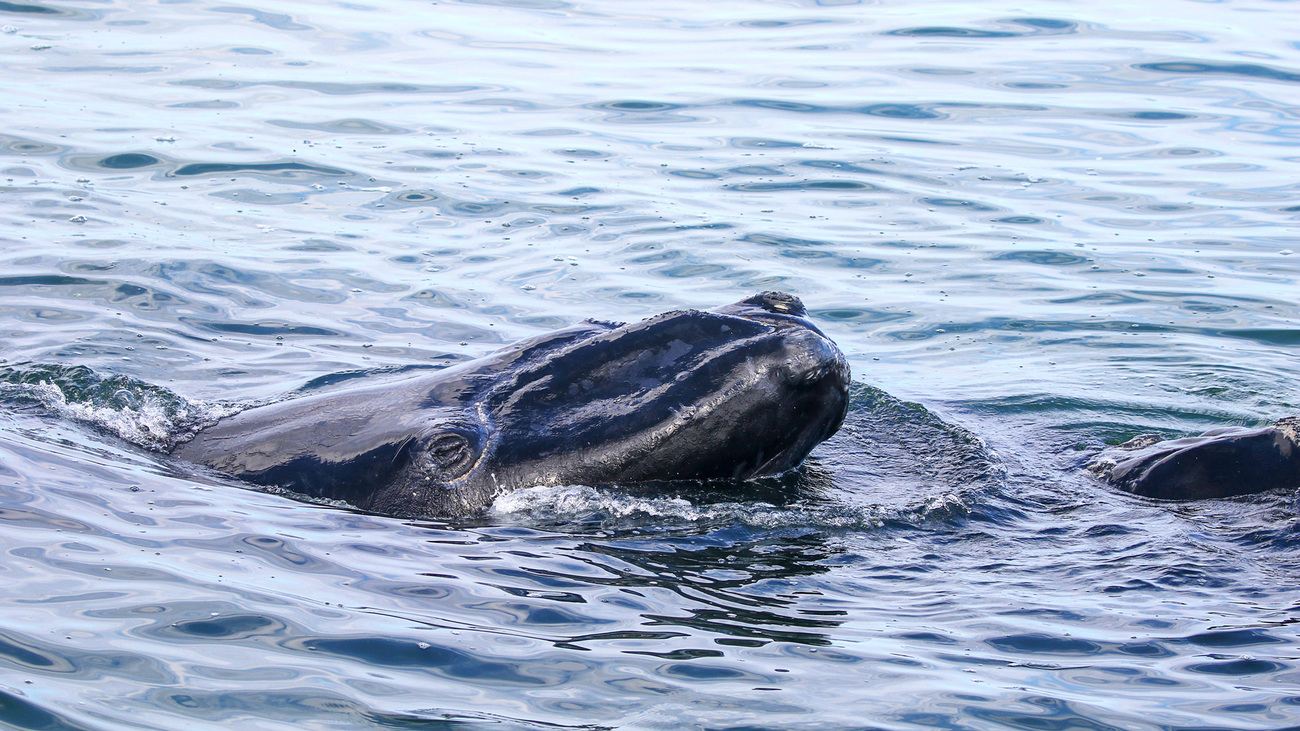
How reproduction works for right whales
Every year, North Atlantic right whales migrate more than 1,000 miles from their northern feeding grounds to the shallow, coastal waters in the southeastern US. This is where they breed and birth their calves.
Potential mothers are at reproductive risk due to escalating stressors in the environment. Research shows that the energetic impacts of sub-lethal entanglements and other stressors are stunting the growth of whales; shorter body lengths are associated with longer birth intervals and low birth rates.
Females that have severe injuries from entanglement have the lowest birth rates. As the health of female right whales declines, their birthing intervals increase.
How many babies do North Atlantic right whales have?
The gestation period for North Atlantic right whales is about one year long. After their year-long pregnancy, the mother gives birth to a single calf. Female North Atlantic right whales typically become sexually mature at 10 years old.
The calving interval for reproductive females is widening. Adult females previously gave birth to a calf every three years, but now they are only calving every six to 10 years, likely due to the additional stress of entanglement, climate change, and other threats.
How long do North Atlantic right whale calves stay with their mothers?
North Atlantic right whale calves are typically weaned at about one year old.
How big are North Atlantic right whale calves?
Newborn North Atlantic right whale calves are about 13 to 15 feet long and weigh about 2,000 pounds. As adults, they grow to 45 to 55 feet long and can weigh up to 70 tons.
How do we keep track of each individual North Atlantic right whale?
Individual whales are easily identified by callosities, which are raised patches of white roughened skin on their heads. North Atlantic right whales are the only whale species that has callosities. Each individual has a distinct pattern of callosities. Callosities appear white because these whales have cyamids, commonly known as whale lice, which are a type of skeleton shrimp parasite.
How do North Atlantic right whales socialize?
Right whales can be observed actively socializing at the ocean’s surface. Whales doing so are known as surface-active groups (SAGs). Their mating occurs in these SAGs. They communicate with each other using low-frequency groans and pulses, which is why ocean noise pollution has such a negative impact on whales.
How do mother and calf North Atlantic right whales interact and bond?
Just like many other mammals, right whale mothers and their calves show strong attachments to each other. A calf often shows affection by swimming on its mother’s back. They also butt heads, and a mother may roll over to swim upside down and hold her calf with her flippers. Young whales need to stay with their mother for eight to 17 months and cannot survive on their own at this age.
Despite living in the ocean, whales are mammals and need to drink milk as babies. Some whale species drink more than 150 gallons of milk per day and gain 100 pounds per day in their first few months, consuming 2% to 10% of their body weight in milk every day. Once they’re old enough, North Atlantic right whales feed on copepods (tiny crustaceans) and zooplankton by taking in water and filtering it through their baleen plates.
As you might imagine, drinking milk underwater is a challenging feat. Whales don’t have lips, so the calves can’t suckle like other mammals—instead, they get into position beneath their mothers, who then eject a pressured stream into their mouths.
Right whale mother and calf pairs are especially hard to find because they tend to ‘whisper’ to their calves instead of producing easily recognizable up calls, which can make it harder to acoustically detect them. This is why ‘real-time’ detections cannot be relied upon and why more protections are needed.
Generally, when baby whales are born, they are delivered tail first to prevent drowning, but in some situations, they are born headfirst.
Fittingly, since baby whales are called calves, adult female whales are called cows, and adult male whales are called bulls.
How do researchers monitor North Atlantic right whales?
Researchers track and monitor North Atlantic right whales because their populations are so low and threatened by human activity. Scientists observe them from the air, the shore, underwater, or on a boat.
The IFAW-commissioned research vessel Song of the Whale has studied North Atlantic right whales through shipping corridors and fishing grounds during their migration. It’s a quiet, non-invasive boat with features in place to reduce noise pollution.
One way researchers aboard Song of the Whale have studied right whales is through the use of hydrophones—sensitive underwater microphones that pick up the whales’ sounds, which can sound similar to a cow’s moo.
Thermal cameras are another method for monitoring these whales; they can make it easier to locate whales at night. They may prove useful on commercial ships—crews could use them to look ahead of the ship’s path, spot whales in advance, and steer clear to avoid vessel strikes.
The researchers aboard the Song of the Whale vessel have also studied concentrations of di-methyl sulfide (DMS), a gas emitted by right whale prey. The aim is to identify potential links between DMS and aggregations of right whales which could help facilitate the creation of a predictive tool allowing management measures to be implemented prior to the arrival of right whales in a given area.
Through both visual and acoustic surveying, experts aboard the Song of the Whale are able to learn more about the whale’s migratory pattern which helps us to better address the risks facing this important species.
Can I see North Atlantic right whales?
Whale watching is a great economic alternative to whaling. As long as it is done correctly, it does not endanger North Atlantic right whales. IFAW has worked with communities to develop safe, sustainable whale watching practices, in which the operators and their customers take responsibility and implement measures to protect whales and the ocean.
To protect right whales against vessel strikes, please consider signing our petition urging Congress to support “slow zones” for boats.